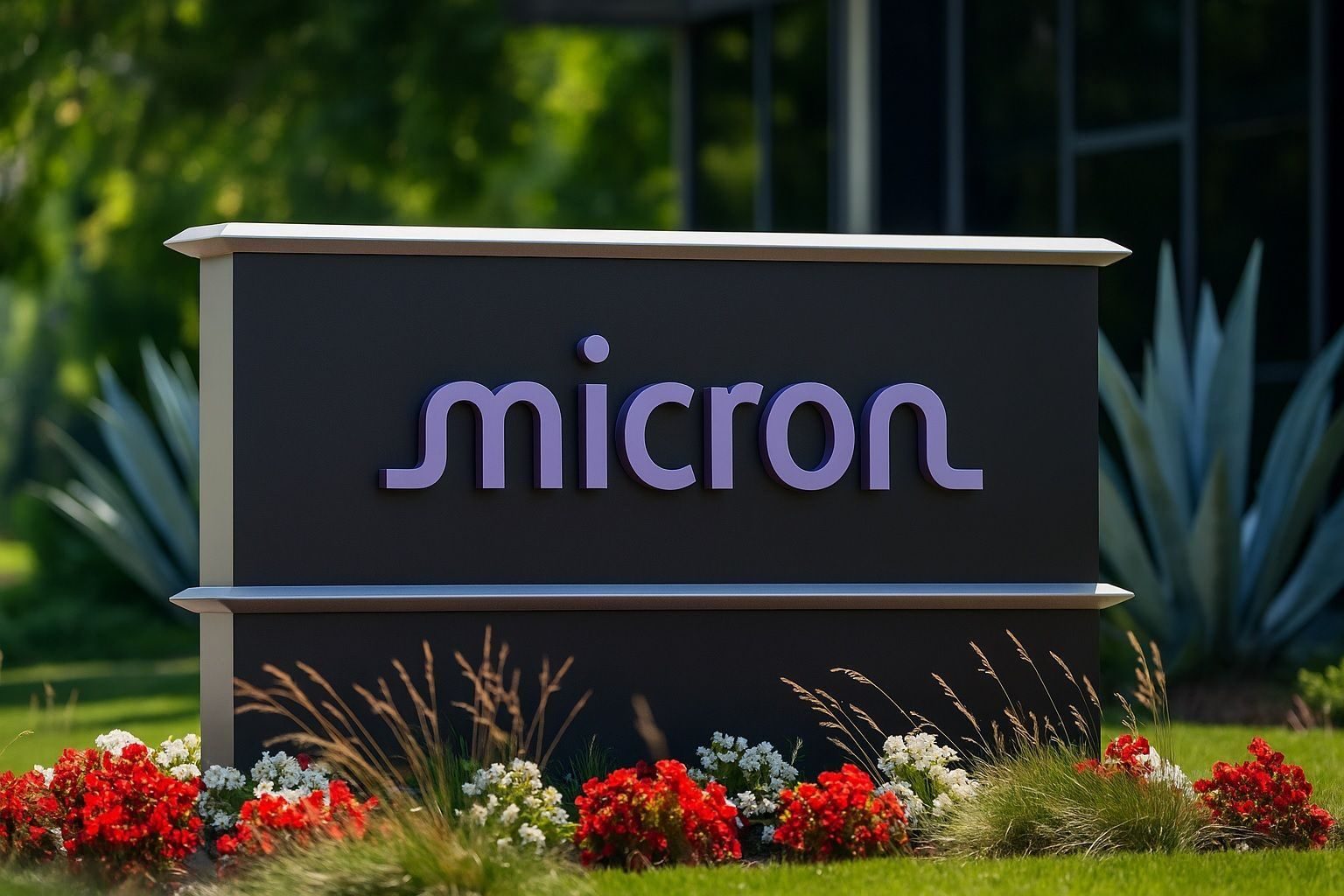Micron Technology stock is back in the spotlight this Black Friday as Wall Street leans harder into the AI memory trade. Fresh analyst upgrades, a stronger credit outlook and a wave of institutional buying are all converging around the stock today.
Micron stock today: near the top of a huge 2025 run
As of Friday, November 28, Micron Technology (NASDAQ: MU) is indicated around $230 per share, keeping it close to the upper end of its 52‑week range of about $61.54 to $260.58. [1]
Analytics site Trefis estimates Micron’s stock has climbed roughly 135% over the past 12 months and about 170% in 2025 year‑to‑date, dramatically outpacing both the S&P 500 and the broader tech sector. [2]
In valuation terms, recent data from MarketBeat puts Micron at a market capitalization of roughly $259 billion, a trailing P/E ratio around 30, and a PEG (price/earnings‑to‑growth) ratio near 0.5, reflecting strong expected earnings growth relative to its current earnings multiple. [3]
For context, U.S. markets are running a shortened post‑Thanksgiving session today, with an early close at 1:00 p.m. Eastern — thin liquidity that can magnify moves in volatile names like MU. TechStock²
Fresh catalysts on November 28: Street‑high $338 target and a credit‑rating boost
A cluster of new, very 2025‑style catalysts is helping keep Micron in traders’ crosshairs today.
1. Morgan Stanley’s Street‑high $338 price target
A widely circulated piece this week highlighted that Morgan Stanley has raised its Micron price target to $338, maintaining an Overweight rating. The call leans heavily on evidence of tight supply and rising prices across DRAM, NAND and especially high‑bandwidth memory (HBM) as AI data‑center demand accelerates. [4]
At a stock price around $230, that target implies almost 50% upside if the bullish scenario plays out.
2. A wall of bullish price‑target hikes
Morgan Stanley is not alone. Recent research round‑ups show:
- UBS, Rosenblatt, Barclays and others have pushed price targets into roughly the $240–$300 range while reiterating Buy or Overweight ratings. TechStock²+1
- MarketBeat’s tally shows five “Strong Buy,” twenty‑six “Buy” and four “Hold” ratings, with a consensus target around $216 — notably below the current share price, a sign that models are still catching up with the rally. [5]
3. S&P Global revises Micron’s outlook to “positive”
On the credit side, S&P Global Ratings has just revised Micron’s outlook to “positive” from “stable” while affirming a BBB‑ range rating, citing AI‑driven growth, stronger cash generation and very low leverage. S&P estimates Micron’s adjusted net leverage at about 0.2×, well below its upgrade threshold of 1×. [6]
The same commentary highlights an aggressive investment plan: Micron expects net capital expenditures to exceed $18 billion in fiscal 2026, up from about $13.8 billion in 2025, with most of that aimed at DRAM and AI‑focused capacity rather than commodity NAND. [7]
4. Zacks calls Micron a “profitable AI winner” for 2026
Separately, a new Zacks screen carried on Nasdaq today singles out Micron and Nvidia as leading “profitable AI picks” for 2026. The screen leans on net income margin, noting that Micron’s 12‑month net margin sits around 22.9%, which is unusually high for a memory maker traditionally known for brutal cycles and thin margins. [8]
Together, those moves reinforce a simple message that markets are digesting today: Micron is no longer being treated as a commodity memory stock, but as a core AI infrastructure play.
Big‑money flows: Norges Bank and other institutions bulk up on MU
Today’s news flow is full of fresh 13F filings showing how large institutions repositioned around Micron in the second quarter — and those filings hit the wires on November 28, so they’re part of today’s narrative.
Among the most notable:
- Norges Bank (Norway’s sovereign wealth fund) disclosed a new position of about 16.07 million Micron shares, worth roughly $1.98 billion, representing around 1.44% of the company. [9]
- The State Board of Administration of Florida Retirement System modestly increased its stake to 1.07 million shares, valued near $132 million, or about 0.10% of Micron’s equity. [10]
- Quadrature Capital Ltd opened a new position of roughly 693,658 shares, worth about $85.45 million, making MU its 11th‑largest holding at roughly 1.5% of its portfolio. [11]
At the same time, a few smaller wealth managers took some profits:
- Choreo LLC cut its Micron stake by 10.2%, selling 2,861 shares and ending the quarter with 25,268 shares valued at about $3.11 million. [12]
- Elevation Point Wealth Partners trimmed its position by 25.9%, selling 3,370 shares to finish with 9,634 shares worth roughly $1.19 million. [13]
Roll all of this together and you get a picture of a stock dominated by professional money: various compilations suggest around 81% of Micron’s float is held by institutions and hedge funds, a very high figure even by large‑cap tech standards. TechStock²+1
For traders, that institutional footprint matters because it tends to amplify reactions to guidance changes, analyst notes and macro headlines — big funds all updating similar models at the same time can drive sharp moves.
Micron’s AI memory supercycle: HBM, DRAM pricing and customer read‑through
The main reason Micron is attracting this level of attention: it’s sitting squarely in the blast radius of the AI infrastructure boom.
Record fiscal 2025 and a very bullish outlook
In its fiscal Q4 2025 results, Micron reported: [14]
- Q4 revenue of $11.32 billion, up 46% year‑over‑year.
- Non‑GAAP EPS of $3.03, more than double the prior‑year quarter.
- Full‑year revenue of $37.38 billion, up about 49% from fiscal 2024.
- Non‑GAAP gross margin around 41% for the year, versus the low‑20s a year earlier.
Management guided for fiscal Q1 2026 (the current quarter) to deliver: [15]
- Revenue of $12.5 billion ± $300 million
- Non‑GAAP gross margin of about 51.5% ± 1 percentage point
- Non‑GAAP EPS of $3.75 ± $0.15
That is an unusually steep earnings ramp for a memory company and is central to the bullish case being repeated across today’s coverage.
HBM3E and sold‑out AI capacity
Analysts and commentators also keep returning to Micron’s position in high‑bandwidth memory (HBM) — the stuff that lives right next to AI GPUs and chews through massive datasets.
Recent previews of today’s trading note that Micron has already locked in pricing agreements for essentially all of its 2026 HBM3E production, with management expecting the company’s entire 2026 HBM supply to be sold out in the near term. TechStock²
Trefis and other analysts, summarising Micron’s disclosures, estimate that: [16]
- The data‑center segment now accounts for roughly 56% of Micron’s revenue, up from much lower levels just a couple of years ago.
- HBM revenue alone reached about $2 billion in Q4 2025, with management and industry forecasts suggesting the overall HBM market could cross $100 billion by 2030, leaving plenty of runway if Micron can defend its share.
Competitors like SK hynix and Samsung are also flagged as having tight memory inventories amid AI demand, with some research suggesting memory prices could rise by up to 50% as suppliers prioritize advanced AI‑grade products. [17]
Customer read‑through from Dell and HP
A widely discussed Barron’s piece today notes that PC and server makers Dell and HP are feeling the impact of rising memory costs, even as they post solid results on the back of AI‑related demand. That article points out that Micron’s stock is up well over 170% in 2025, using Dell and HP’s results as evidence of a sustained, price‑supportive memory upcycle rather than a one‑off spike. [18]
In short: the AI memory arms race has turned Micron from a cyclical afterthought into a key bottleneck supplier for Nvidia, cloud providers and large OEMs — at least for now.
Upcoming catalyst: December 17 earnings and AI guidance
Micron’s next major test arrives in just a few weeks.
The company is scheduled to report fiscal Q1 2026 results on December 17, 2025, with a conference call slated for 2:30 p.m. Mountain time. TechStock²+1
Investors will be watching for:
- Whether Micron hits or raises that ambitious Q1 revenue and EPS guidance. [19]
- Updated commentary on HBM supply, AI server demand and pricing into 2026. TechStock²+1
- Progress on capacity expansions tied to that >$18 billion 2026 capex plan. [20]
- Any clarity on China exposure, after reports that Micron is effectively exiting server‑memory sales to data centers located in mainland China while focusing on non‑Chinese hyperscalers and automotive/mobile customers. TechStock²+1
Given how much of today’s valuation is built on multi‑year AI earnings expectations, the December call is likely to be a major volatility event.
Valuation, volatility and the risks the market is debating
With the stock having already gone into orbital mode, the conversation today is less “is Micron cheap?” and more “how far can this run before the cycle turns?”
Rich valuation, but backed by exploding earnings
- Trailing P/E around 30 and a PEG near 0.5 suggest investors are paying a growth multiple, but not an obviously bubble‑level one given Micron’s earnings trajectory. [21]
- Over the last year, Trefis estimates Micron’s net income margin expanded from roughly 3% to nearly 23%, while revenue grew almost 49%. That margin expansion explains much of the 135%+ share‑price gain since late 2024. [22]
Options market is pricing in big swings
Options data for contracts expiring November 28, 2025, show implied volatility in the low‑60% range and a roughly 68% probability range of about $185 to $268 for Micron’s share price. [23]
Translation: the derivatives market expects big moves in both directions, consistent with a stock that has become one of the main trading vehicles for the AI theme.
Key risks making even bulls nervous
Recent research pieces and today’s pre‑market outlooks highlight several downside scenarios investors are wrestling with: MarketBeat+4TechStock²+4Investing.com+4
- Cyclical overcapacity: Micron is ramping capex aggressively. If AI demand slows or competitors overbuild DRAM and HBM, today’s high margins could compress fast.
- AI spending normalization: Much of the bull case assumes sustained, rapid growth in AI server deployments. A pause in cloud capex, economic slowdown or architectural shifts could hit both volumes and pricing.
- Geopolitics and China risk: Micron already faces restricted access to certain Chinese infrastructure markets and is reportedly exiting server‑memory sales to China‑based data centers, concentrating its growth more in the U.S. and allied markets.
- Concentration risk: With more than half of revenue now tied to data centers and AI, Micron is less diversified than in prior cycles. That’s great while AI is hot, risky if AI infrastructure spending cools. [24]
- Insider selling and expectations bar: MarketBeat data show insiders have sold roughly 400,000 shares worth about $85 million in recent months, including sales by top executives. While many trades are under pre‑set plans, they underscore how high the expectations bar has become after a 160%+ rally. [25]
What today’s news really adds to the Micron story
Put all of today’s moving pieces together and you get a fairly clear picture of how the market is framing Micron right now:
Bullish side of the ledger
- Structural AI tailwind: Micron is deeply embedded in AI data centers through HBM and advanced DRAM, with 2026 HBM supply effectively spoken for. TechStock²+1
- Explosive earnings ramp: Revenue and margins are tracking more like a high‑end logic company than a classic memory name; guidance implies further growth into 2026. [26]
- Balance‑sheet strength: S&P’s move to a positive outlook and very low net leverage give Micron room to invest heavily without over‑stretching its finances. [27]
- Institutional conviction: Multi‑billion‑dollar positions from sovereign wealth funds and large pensions signal long‑term confidence, not just speculative hot money. [28]
Cautious side of the ledger
- Cycle risk isn’t dead: Every memory supercycle eventually runs into overcapacity. The only real unknown is when. [29]
- Valuation and sentiment are elevated: After a 160%‑plus run, even good news may already be priced in, making the stock vulnerable to any disappointment in December’s earnings or AI capex commentary. [30]
- Geopolitical and regulatory uncertainty: Exposure to U.S.–China technology tensions and export controls remains a persistent overhang. [31]
For long‑term investors, the core question after today’s headlines is whether Micron’s transition into an AI‑first, HBM‑heavy business can sustain margins through the inevitable ups and downs of the memory cycle. For short‑term traders, the combination of Street‑high targets, heavy institutional positioning and high implied volatility makes Micron one of the central battleground stocks heading into December’s earnings and the next phase of the AI build‑out.
This article is for informational purposes only and does not constitute investment advice, a recommendation to buy or sell any security, or a prediction of future performance. Always do your own research or consult a qualified financial advisor before making investment decisions.
References
1. www.marketbeat.com, 2. www.trefis.com, 3. www.marketbeat.com, 4. coincentral.com, 5. www.marketbeat.com, 6. www.investing.com, 7. www.investing.com, 8. www.nasdaq.com, 9. www.marketbeat.com, 10. www.marketbeat.com, 11. www.marketbeat.com, 12. www.marketbeat.com, 13. www.marketbeat.com, 14. investors.micron.com, 15. investors.micron.com, 16. www.trefis.com, 17. coincentral.com, 18. www.barrons.com, 19. investors.micron.com, 20. www.investing.com, 21. www.marketbeat.com, 22. www.trefis.com, 23. quantcha.com, 24. www.trefis.com, 25. www.marketbeat.com, 26. investors.micron.com, 27. www.investing.com, 28. www.marketbeat.com, 29. investors.micron.com, 30. www.trefis.com, 31. coincentral.com







